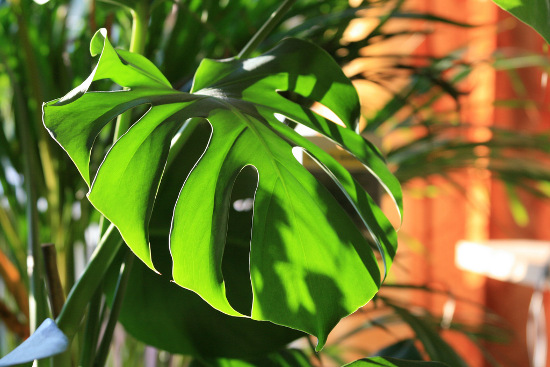Why sawn wax leaves with holes?
Great calculations have helped scientists solve a difficult problem, haunting them for over 100 years. It turns out that the leaf holes and the zigzag fringe made the bonsai very popular in the interior - called the mulch - green in four seasons by adapting well to low light conditions.
Professor Christopher Moore, Indiana University (USA) has come up with a new hypothesis to explain the unusual shape of the sawn tree, often grown indoors as ornamental plants. His hypothesis is presented in the American Journal The American Naturalist.

The holes in the leaves help the plants in the house
This helps them use sunlight to photosynthesize.
Since the end of the nineteenth century, botanists have argued that holes and defect parts on the leaves of the birch tree (scientific name: Monstera deliciosa), grow wild in the tropical South American rain forests, making it easy. Easy to endure torrential rains, high winds. It is also thought that the shape helps them to regulate the temperature, against the disadvantage of hot weather.
But according to GS Moore, all of these theories are unfounded. He pointed out that the presence of holes and imperfections on the leaf margins (making it unique when cultivated as a landscape) is due in large part to the fact that the plant is hidden under the dense foliage of the leaves. Big trees, it is difficult to reach the sun and must be photosynthesized by random pieces of sunshine falling on the leaves.
It is because of these characteristics of the leaves of the leaves that the tree 'enlist' captures the maximum amount of rare light that comes to you.
Sunbeams through the leaves are always wavering because of the wind, it is unpredictable to reach the position of the tree. Moore's hypothesis also explains why the leaves of the mulberry tree are still young with no holes. For example, when growing up, clinging to the host to climb higher, being exposed to sunlight more often. In the lower floors, when the tree is still young, there is little contact with the light.
Mathematical calculations show that, when the leaves have the same area, the more slits the leaf has, the more chance it will take to catch the random rays of sunlight.
Moore stressed that his hypothesis could be tested experimentally by placing sensors beneath the hollowed-out leaves to determine which leaves caught the light better. According to him, the presence of holes is not a gift that Nature 'gives' to a tree. Because leaves are not reduced in durability compared to the past, plants must 'pay' by adding a significant amount of tissue to reinforce (increase durability) around the edges of the leaves.
- Is 2x4 sawn timber really 2x4?
- American kiosks
- Special technology leaves the leaves after a few hours
- Turn leaves into creativity 'no one expected
- 15 items of medicine from bamboo
- Beams of maple leaves fall extremely romantic and beautiful
- Millions of black holes are hiding in our galaxy
- Simple cure with leaves
- Why are leaves green?
- Decoding mistakenly thought that the black hole of the universe is
- Autumn leaves
- Why can earthworms eat contaminated leaves?
 Why do potatoes have eyes?
Why do potatoes have eyes? 'Tragedy' the world's largest carnivorous life: Death becomes ... public toilet
'Tragedy' the world's largest carnivorous life: Death becomes ... public toilet Tomatoes were once considered 'poisonous' for 200 years
Tomatoes were once considered 'poisonous' for 200 years Detecting microscopic parasites on human face
Detecting microscopic parasites on human face